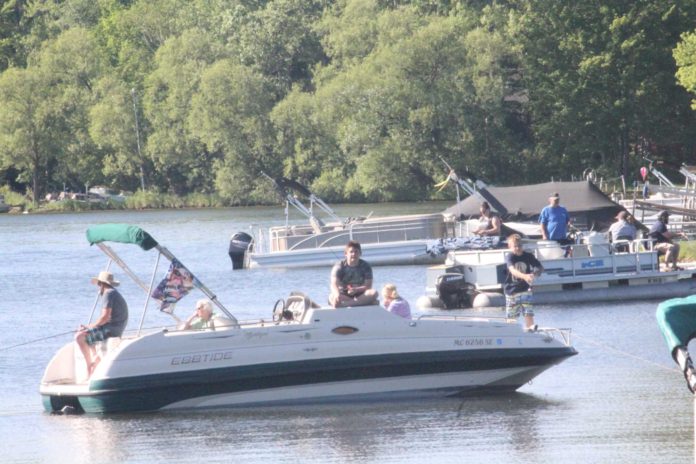In Mecosta County, “things are good, lots of walleye are being caught,” Tom Vernon, of Frank’s Sporting Goods in Morley said. “The same with the bluegills and pretty much the same with all the panfish. They’ve gone deep. They’re getting bluegills anywhere from 15 to 25 foot range. Walleyes are 15 to 23 foot of water. It’s never slowed down.”
In Osceola County, “people are out and about,” Brad Cox, of Bucks County Bait & Store in LeRoy said. “They’re getting quite a few decent panfish in the area. Trout fishermen have been out.”
Chinooks were starting to show up on a regular basis at Frankfort, the DNR said. Anglers are finding the temperature break down around 58 feet, trolling in water 105 to 140 feet and working above and below the break, the DNR added while mentioning the morning bite is reporting good numbers, but the afternoon/evening bite was also producing a good mix of steelhead, coho, lake trout and Chinook.
“It’s going pretty good if the wind stays down,” Christine Murphy, of the Frankfort Tackle Box said. “There’s lots of lake trout and catches are limiting out. People are catching perch too. The salmon, a 33-pounder was caught last weekend just north of Frankfort pier. Last Friday, fishing of the Frankfort pier, they got a 29-pound brown trout. My husband Brian last Friday got a 24-pound lake trout on the boat. That’s nice stuff. All the little lakes are doing well.”
Flashers/flies and meat rigs seem to be landing the bigger 20+ pound Chinooks.
Anglers heading straight out to 120 to 150 feet of water and working the top 70 feet of water were reporting some Chinooks and lake trout in the early mornings at Onekama, the DNR said. Later in the day, anglers were moving into the Barrel to land a few lake trout. Green and blue spoons and flies were the ticket, the DNR said.
Anglers trolling in front of the golf course at Arcadia were reporting a few Chinooks and lake trout in the early mornings, the DNR added.
“They’re getting some nice salmon and lake trout,” Dewey Buchner from Don’s Sporting Goods in Manistee said. “The depth has been changing. Most of it has been 170 feet of water. That changes every day. In Manistee lake, they ‘re getting nice bass and pike and panfish.”
Most anglers were fishing offshore and had some luck with lake trout and cisco at Charlevoix, the DNR said. Anglers were mainly targeting smallmouth bass in the channel in Charlevoix with real and artificial worms. A few keepers were caught.
A few Chinook were caught along the shelf in 100 to 300 feet of water and south towards Big Sable Point at Manistee, the DNR said. Spoons and flasher fly combos worked at depths of 30 to 70 feet. Lake trout were caught at 90 to 110 feet while fishing near bottom and in the mix when fishing for salmon, the DNR said, adding a few steelhead were caught as well, usually from the top 30 feet. The north pier was slow.
“We’re starting to get some silver fish,” Bud Fitzgerald of Tangled Tackle Co., said. “It breaks down to about 24 to 34 feet. Meat rigs are doing the best. Right now, we’re starting to get some walleye in the river. They’re still getting bluegill around the weeds.”
A few Chinook and coho were netted straight out from the harbor and near Big Sable Point, the DNR added. Spoons and flies were effective. The salmon were anywhere from 120 to 200+ feet of water and at 100 to 160+ feet of water off the point. Lake trout and steelhead were also in the mix from depths of 60 to 150 feet of water, the DNR said.
Lake trout fishing was effective in 100 feet of water. In the harbor, smaller salmon were caught while trolling. A few smallmouth bass were caught near the rocks in the harbor as well.
Fishing Tip: Fishing for bass at night
Courtesy of the Michigan DNR
With summer in full swing, fish can become quite lethargic. No need to fret! For certain species, such as bass, you just might want to tweak the time of day you set out to target them.
Some of the best bass fishing this time of year occurs during the first hour or so after dark. You still can find fish at dusk and dawn, but that first hour or two after dark can be exceptional.
After dark, bass tend to move shallow in search of an easy meal. Target them near the same areas you would during other times of the day while also casting and targeting the shallows.
You’ll want to change your technique, though. Since after dark you can’t see the weed line or other underwater structures, fishing subsurface lures is not recommended. It is time for surface presentations. After the cast, work them aggressively with a jerking motion, making sure they pop and gurgle across the surface of the water during your retrieve. Pay close attention during the retrieve, watching and listening for the strike, which can be explosive.
If you’re feeling adventurous, get on the water at 10 p.m. and fish the shallows for bass until midnight or 1 a.m. The results can be spectacular.
Credit: Source link































